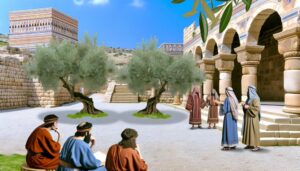Dome Meaning in the Bible: Covering and Protection
In the Bible, the term ‘dome’ is often linked to the concept of the firmament, or rākīa‘ in Hebrew, described as a vast, solid expanse that separates the earthly and divine domains (Genesis 1:6-8). This imagery aligns with ancient Near Eastern cosmologies seen in Mesopotamian and Egyptian cultures.
Domes in biblical architecture, such as temple structures, symbolize the intersection of the terrestrial and celestial, facilitating worship by directing focus upward. Symbolically, the dome embodies divine protection, order, and the transcendence of God, resonating with theological themes of creation and covenant.
Further exploration reveals intriguing insights into the spiritual and cultural significance of domes in biblical contexts.

Dome Meaning in the Bible: Symbolism of the Heavens and Divine Protection
| Concept | Biblical Interpretation | Key Verses |
|---|---|---|
| Firmament (Heavens) | Dome represents the sky or expanse separating waters | Genesis 1:6–8 |
| Divine Separation | Divides waters above from waters below | Genesis 1:7 |
| Symbol of God’s Power | God’s authority over creation | Psalm 19:1, Isaiah 40:22 |
| Heavenly Canopy | Imagery of the sky as a tent or dome over the earth | Job 37:18, Isaiah 40:22 |
| Spiritual Meaning | Represents divine order, protection, and transcendence | Ezekiel 1:22–28 |
The Dome of the Heavens

Within the framework of ancient Near Eastern cosmology, the ‘Dome of the Heavens‘ is often conceptualized as a solid firmament that separates the earthly sphere from the divine.
This cosmological model is evident in the Hebrew Bible, particularly in Genesis 1:6-8, where God creates a firmament to divide the ‘waters above‘ from the ‘waters below.’
The firmament, or rākīaʿ, is perceived as a vast, solid expanse, akin to a dome, arching over the earth. This depiction aligns with contemporary Mesopotamian and Egyptian cosmologies, signifying a shared regional understanding of the universe’s structure.
The conceptualization of the firmament underscores the demarcation between human and divine spheres, reflecting a theological framework that emphasizes order and separation in creation.
Domes in Temple Architecture

The conceptual imagery of the firmament as a dome finds its architectural counterpart in the domes that crown many ancient temples, symbolizing the intersection of the earthly and the divine.
Domes in temple architecture serve several functions:
- Structural Integrity: Domes distribute weight evenly across a building, enhancing stability and allowing for larger, open interior spaces.
- Acoustic Enhancement: The curvature of domes improves sound propagation, facilitating clearer transmission of liturgical chants and spoken words.
- Visual Magnificence: Domes create a focal point that draws the eye upward, directing worshippers’ attention toward the heavens.
These architectural elements underscore the theological significance of temples as sacred spaces bridging human and divine domains.
The use of domes consequently encapsulates the spiritual ethos reflected in biblical descriptions of the heavens.
Symbolism of Celestial Domes

Often depicted as the celestial firmament, domes in biblical symbolism are imbued with profound theological significance, representing the heavens as a divine canopy over the Earth.
This metaphorical imagery aligns with the ancient Near Eastern cosmology, wherein the sky is envisioned as a solid dome separating the earthly territory from the divine.
In Genesis 1:6-8, the ‘firmament’ is described as God’s creation, partitioning the waters above from the waters below, thereby establishing order.
The dome’s curvature alludes to the encompassing nature of divine protection and omnipresence, reinforcing God’s sovereignty over creation.
Additionally, its symbolic elevation denotes the transcendence of the divine, inviting believers to contemplate the grandeur and mystery of the heavenly sphere.
God’s Covenant and the Dome

In examining God’s covenant in the context of the dome, it becomes evident that the firmament serves not only as a physical separator but also as a symbol of the divine promise of order and protection. This interpretation can be elucidated through several key aspects:
- Divine Order: The firmament, as described in Genesis, establishes a structured cosmos, reflecting God’s intent for harmony.
- Covenantal Assurance: The dome signifies God’s enduring commitment to humanity, exemplified in covenants such as that with Noah.
- Protection: The firmament acts as a protective covering, safeguarding creation from chaos and maintaining the stability of the world.
These elements collectively highlight the dome’s role in underscoring the theological dimensions of God’s covenant.
Spiritual Sanctuary and Protection

As a symbol of spiritual sanctuary and protection, the dome in biblical literature encapsulates the divine shelter afforded to believers under God’s watchful care. This imagery evokes a sense of safety and peace, reinforcing the theological notion that God provides a refuge from worldly adversities. This protective imagery finds expression in various passages, where the dome signifies not merely physical shelter but also spiritual fortitude. The concept of sanctuary gains fortified meaning in biblical context as it reflects God’s unwavering presence and guidance amidst life’s trials. Through this lens, believers are encouraged to seek solace in their faith, knowing that the divine dome shields them from both external turmoil and internal strife.
The dome serves not merely as an architectural feature but as a metaphor for divine guardianship, enveloping the faithful within a sacred space. The following table delineates key aspects of this symbolism:
| Aspect | Description |
|---|---|
| Symbolism | Represents divine protection |
| Theological Context | Affirms God’s sheltering presence |
| Comparative Imagery | Similar to the ‘winged refuge’ in Psalms |
| Spiritual Implication | Encourages faith in God’s unwavering guardianship |
This representation enhances our understanding of the dome’s profound spiritual significance in biblical contexts.
Conclusion
The concept of the dome in biblical literature serves as a multifaceted symbol embodying divine protection, celestial order, and spiritual sanctuary.
Like a celestial canopy, the dome not only signifies the heavens but also reflects the intricate relationship between the divine and the earthly domain.
Its presence in temple architecture and covenantal imagery underscores its integral role in conveying theological themes and spiritual truths, thereby enriching the biblical narrative with layers of metaphysical meaning.






